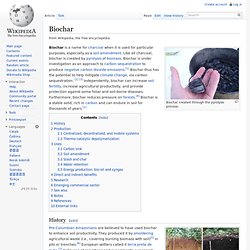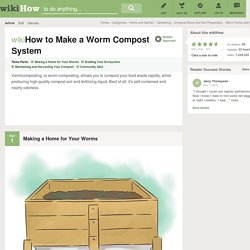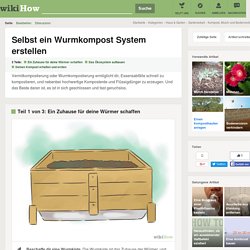

2015 International Year of Soils. Symphony of the Soil. Dirt! The Movie (FULL) Joel Salatin at TEDMED 2012. How to Compost: 7 Steps. Biochar. Biochar created through the pyrolysis process.

History[edit] Left - a nutrient-poor oxisol; right - an oxisol transformed into fertile terra preta using biochar Pre-Columbian Amazonians are believed to have used biochar to enhance soil productivity. They produced it by smoldering agricultural waste (i.e., covering burning biomass with soil)[5] in pits or trenches.[6] European settlers called it terra preta de Indio.[7] Following observations and experiments, a research team working in French Guiana hypothesized that the Amazonian earthworm Pontoscolex corethrurus was the main agent of fine powdering and incorporation of charcoal debris to the mineral soil.[8] The term “biochar” was coined by Peter Read to describe charcoal used as a soil improvement.[9] Production[edit] Pyrolysis produces biochar, liquids, and gases from biomass by heating the biomass in a low/no oxygen environment.
Centralized, decentralized, and mobile systems[edit] Thermo-catalytic depolymerization[edit] Uses[edit] Biochar Workshop Part 1, How to Make Biochar. International Biochar Initiative. Urin als Dünger. Sobald man im eigenen Garten beginnt in geschlossenen Stoffkreisläufen zu denken, kommt man am Thema Urin als Dünger eigentlich nicht vorbei.

Dabei mag der Umgang mit Urin für den einen oder anderen Menschen zunächst einmal befremdlich wirken, um es gelinde auszudrücken. Allerdings kommt man über eine eventuelle Ekelschwelle schnell hinweg, wenn man sich bewusst macht, dass der frische Urin eines gesunden Menschen frei von jeder mikrobiellen Belastung und – außerhalb der Spargelzeit – jedweden unangenehmen Gerüchen ist. Diese entstehen erst durch den Kontakt mit Bakterien und lassen sich durch einfache Techniken auch weitgehend vermeiden. Flüssiges Gold Unser Körper ist eine wunderbare Stofftrennungsanlage, die einerseits energiearme und kohlenstoffreiche Feststoffe sowie andererseits energiereiche und kohlenstoffarme Flüssigkeiten ausscheidet.
Menschlicher Urin ist z.B. eine hervorragende Quelle für das Wachstumshormon Auxin. Aus der Vergangenheit lernen Auf die Ernährung kommt es an. IASS Potsdam. The Soil Solution to Climate Change Film.
Worm Composting. How to Vermi-Compost in your Apartment. How to make a Worm Farm from a Wheelie Bin. How to Make a Worm Compost System: 10 Steps. Steps Part 1 Making a Home for Your Worms <img alt="Image titled Make a Worm Compost System Step 1" src=" width="728" height="546" class="whcdn" onload="WH.performance.clearMarks('image1_rendered'); WH.performance.mark('image1_rendered');">1Obtain a worm bin.

The worm bin is basically the home for the worms, and the place where they digest the organic material you will give them. Worm bins can be purchased from many online vendors, or from your local gardening or farm supply store. <img alt="Image titled Make a Worm Compost System Step 4" src=" width="728" height="546" class="whcdn">4Place the worm bin in a cool area to protect it from excessive heat. Part 2 Building Your Ecosystem. Selbst ein Wurmkompost System erstellen.
Vorgehensweise Teil 1 von 3: Ein Zuhause für deine Würmer schaffen <img alt="Bildtitel Make a Worm Compost System Step 1" src=" width="728" height="546" class="whcdn">1Beschaffe dir eine Wurmkiste.

Die Wurmkiste ist das Zuhause der Würmer, und der Ort wo sie das pflanzliche Material, dass du ihnen gibst, verdauen. Kompost aus der Kiste - Bauanleitung für eine Wurmkiste aus Holz. Hungry bin. A continuous flow worm farm.